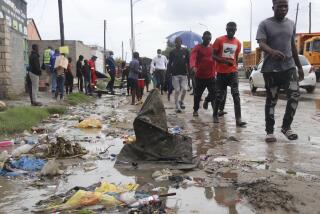Scientists Confirm Ebola Is Causing Deadly Outbreak in Zaire : Medicine: Investigators find near-deserted hospital and 20 new cases. But disease not expected to spread far.
- Share via
WASHINGTON — As scientists confirmed Thursday that Ebola hemorrhagic fever was the cause of a lethal outbreak in Zaire, African authorities took extraordinary measures to contain the virus’ spread and the panic it can cause.
World Health Organization officials who arrived at the original infection site--the village of Kikwit, about 250 miles east of the Zairian capital of Kinshasa--said they found the 350-bed hospital where most victims had been now was abandoned, except for about 20 patients.
They said many of the staff and care-givers who likely had been exposed had fled, and they expected more cases of the deadly illness would occur in the vicinity.
The WHO team also reported another suspected 20 cases in a second hospital, 60 miles south of Kikwit, that had taken in one of the Kikwit patients.
“Given that many patients have left the Kikwit hospital, we must expect some additional transmission of the disease,” said Dr. Ralph Henderson, an assistant director-general at WHO. “However, we believe this will be limited to people who are in prolonged intimate contact with sufferers of the disease. It is unlikely that this outbreak will have implications for Zaire as a whole, or for international travel.”
Bernadin Mungul Diaka, governor of Kinshasa, said he has barred the movement of all people into the capital from Bandundu, the region where scores have fallen ill and died. Health officials’ worst fear is that the disease will be carried into the packed, bustling capital.
Officials at the Atlanta-based federal Centers for Disease Control and Prevention, which sent a three-person team that arrived in Zaire on Thursday, said they believe that the potential for Ebola spreading outside Zaire is low.
But they urged U.S. public health officials and clinicians to be alert to signs and symptoms of the disease and warned them to take precautions if cases are suspected.
“The impacted area is remote and infrequently visited, and there is no direct air service between the United States and Zaire,” the agency said in a statement. But officials cautioned that physicians who see signs of the illness should “question persons . . . about recent travel to Africa and should assure proper isolation, if Ebola infection is suspected, and contact local (or) state health officials.”
Dr. Steve Ostroff, associate director for science at CDC’s National Center for Infectious Diseases, said the task of the agency team working with WHO and Zairian officials is first and foremost “to get on site, try to figure out if the cases are continuing and where the disease is occurring.”
The death toll and caseload remain unclear, though some accounts have listed the number of dead as 170 or more.
Ebola is characterized by sudden onset of fever, malaise, muscle pain and headache, followed by vomiting and diarrhea. Often, severe internal hemorrhaging occurs--in which once-solid body organs dissolve and turn mushy--and blood flows from the eyes, nose and other openings. It is transmitted through exposure to bodily fluids, especially blood, and not through casual contact. Death often occurs in days or weeks of infection. There is no treatment or vaccine.
Ostroff said CDC scientists conducted tests earlier this week on blood samples from infected patients in the agency’s biosafety Level 4 laboratory, a high-security facility used to study the most deadly organisms.
By Tuesday, their tests had detected antibodies to Ebola--a sign of viral exposure--and by Wednesday they confirmed the presence of viral antigens, meaning the presence of the virus itself.
All who have experience with Ebola describe it as a ghastly illness. “This is one of the most wicked bugs you could ever imagine,” said Dr. Don Francis, a U.S. virologist and infectious disease expert who in 1976 investigated the first outbreak of the disease in Africa for CDC. “These people are oozing blood all over when they die. They’re just eaten up.”
Francis said African customs, particularly the washing of the dead by villagers before funerals, contributes to the spread of the disease, exponentially many times more infectious than the human immunodeficiency virus, which causes AIDS.
“If you stick a needle into yourself that has been in an AIDS patient’s blood, there’s a 1 in 2,000 chance you’ll get infected,” said Francis, now a scientist with Genentech Inc., a biotechnology company in South San Francisco. “If you do the same with Ebola, you’ve got a 90% chance of dying.”
Ostroff said the work of U.S. disease detectives will not end once the epidemic is contained because so much remains unknown about the virus: “There were many of us who thought Ebola was gone. Where does this virus live? Where the devil does it come from? And where has it been for the past 16 years?”
Ostroff and Francis said, among other things, that scientists have never identified the virus’ natural host.
The only previous major outbreaks of Ebola occurred in Zaire and nearby Sudan in 1976 and in Sudan in 1979. Both Sudan episodes began in the same local cotton factory. Bats and other animals were studied to no avail.
More to Read
Sign up for Essential California
The most important California stories and recommendations in your inbox every morning.
You may occasionally receive promotional content from the Los Angeles Times.












